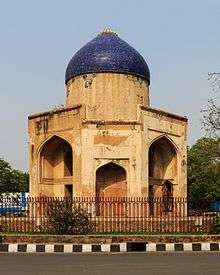Persian blue
| Persian Blue | |
|---|---|
 | |
| Common connotations | |
| Lapis lazuli Celestial sphere Heaven | |
| Hex triplet | #1C39BB |
| sRGBB (r, g, b) | (28, 57, 187) |
| CMYKH (c, m, y, k) | (100, 100, 21, 11) |
| HSV (h, s, v) | (249°, 85%, 49%) |
| Source | and Maerz and Paul[1] |
|
B: Normalized to [0–255] (byte) H: Normalized to [0–100] (hundred) | |
Persian blue (not to be confused with Prussian blue) comes in three major tones: Persian blue proper—a bright medium blue; medium Persian blue (a medium slightly grayish blue that is slightly indigoish); and a kind of dark blue that is much closer to the web color indigo; this darker shade of Persian blue is referred to as Persian indigo, dark Persian blue, or regimental.
Other colors associated with Persia include Persian pink, Persian rose, Persian red and Persian green.
Persian blue
The color Persian blue is named from the blue color of some Persian pottery and the color of tiles used in and on mosques and palaces in Iran and in other places in the Middle East. Persian blue is a representation of the color of the mineral lapis lazuli which comes from Persia (i.e. modern Iran) and Afghanistan. (The color azure is also named after the mineral lapis lazuli.)
The first recorded use of Persian blue as a color name in English was in 1669.[2]
Variations of Persian blue
Medium Persian blue
| Persian Blue (ISCC-NBS #178) | |
|---|---|
| Hex triplet | #0067A5 |
| sRGBB (r, g, b) | (0, 103, 165) |
| CMYKH (c, m, y, k) | (100, 100, 21, 11) |
| HSV (h, s, v) | (248°, 75%, 48%) |
| Source | ISCC-NBS |
|
B: Normalized to [0–255] (byte) H: Normalized to [0–100] (hundred) | |
The medium tone of Persian blue shown at right is the color called Persian blue in color sample #178 of the ISCC-NBS color list.
The source of this color is the ISCC-NBS Dictionary of Color Names (1955), a color dictionary used by stamp collectors to identify the colors of stamps, now on the Internet—see sample of the color Persian blue (color sample #178) displayed on indicated web page: .
Persian indigo
| Persian Indigo | |
|---|---|
| Hex triplet | #32127A |
| sRGBB (r, g, b) | (50, 18, 122) |
| CMYKH (c, m, y, k) | (96, 100, 16, 11) |
| HSV (h, s, v) | (258°, 85%, 48%) |
| Source | /Maerz and Paul[3] |
|
B: Normalized to [0–255] (byte) H: Normalized to [0–100] (hundred) | |
The color Persian indigo is displayed at right. Another name for this color (seldom used nowadays) is regimental. The color was called regimental because in the 19th century it was commonly used by many nations for navy uniforms.
Persian indigo is named for an association with a product from Persia: Persian cloth dyed with indigo.
The first recorded use of regimental (the original name for the color now called Persian indigo) as a color name in English was in 1912.[4]
Persian blue and its variations in human culture

- Many mosques in Iran, such as the enormous Shah Mosque in Isfahan, have interiors that are faced with tiles that are Persian blue or close variations of it.[5]
- The color Persian indigo, which as noted above was originally called regimental, was called by that name because it used to be the color of the navy uniforms of a number of different nations in the late 19th and early 20th centuries due to the fact that it was easy and inexpensive to use indigo dye to dye navy uniforms.
- The metaphysical books (on topics such as the seven rays) written by the New Age Prophetess Alice A. Bailey (which she claimed to have channeled from the ascended master Djwal Khul), published by the Lucis Trust and called by her followers the Alice A. Bailey material, in earlier editions up to and including the 1970s were originally bound in matte medium Persian blue, but since the 1980s, they have been bound in glossy Persian blue.
- When blue Persian carpets are produced in Iran, medium Persian blue is one of the most commonly used tones of blue.
References
- ↑ The color displayed in the color box above matches the color called Persian blue in the 1930 book by Maerz and Paul A Dictionary of Color New York:1930 McGraw-Hill; the color Persian blue is displayed on page 95, Plate 36, Color Sample L4.
- ↑ Maerz and Paul A Dictionary of Color New York:1930 McGraw-Hill Page 201; color sample of Persian blue: Page 95 Plate 36 Color Sample L4
- ↑ The color displayed in the color box above matches the color called regimental in the 1930 book by Maerz and Paul A Dictionary of Color New York:1930 McGraw-Hill; the color regimental is displayed on page 117, Plate 47, Color Sample C10.
- ↑ Maerz and Paul A Dictionary of Color New York:1930 McGraw-Hill Page 203 (It is also stated under the entry on Persian Blue on page 201 that the color on Plate 47 Color Sample C10 (regimental) is a [darker] tone of Persian Blue.); color sample of Regimental: Page 117 Plate 47 Color Sample C10
- ↑ Picture of the Interior of the Shah Mosque: